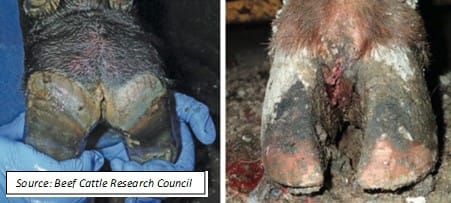Foot Rot in Beef Cattle

Foot Rot is a common cause of lameness in beef cattle – whether they are in a feedlot or on pasture.
It appears suddenly, is painful, and must be treated promptly.
What causes Foot Rot?
Bacteria that thrive in an environment without oxygen (“anaerobes”). These bacteria are found in the environment and only cause disease when able to invade the skin barrier into the soft tissues of the foot.
What does Foot Rot look like?
- Sudden onset of lameness
- Swelling in between the toes
+/- malodorous discharge
- Possible weight loss due to difficulty travelling to feed/water
Why are some years better or worse than others for Foot Rot?
- Weather factors, e.g. extended periods of wet (softens skin) or dry (cracks skin)
- Changes in bacterial strains with ↑/↓pathogenicity (i.e. ability to cause disease)
How do you prevent Foot Rot in your herd? – Prevention centres around two things
1) General health (contributes to a strong immune system)
- Good nutrition including trace minerals (zinc, biotin) +/- medicated feed
- Low-stress management and handling
- Vaccination as recommended by your vet
2) Skin/Hoof health and integrity
- Good hygiene: Manure and urine is wet and acidic (i.e. irritating to the skin). Clean, dry pens and pasture rotation will reduce contact of waste with the soft tissues of the foot.
- Reduce injurious terrain/surfaces: E.g. abrasive pen surfaces, stones/sticks/etc. that could puncture the skin
What do you do when you suspect your cow/bull has Foot Rot?
- If able, safely examine the foot to rule out other causes of lameness
- Treat with a vet-recommended antibiotic (such as long acting tetracycline). Improvement will occur in 3-4 days.
- If there is no improvement, consult your vet since the cause of lameness may not be foot rot or the Infection has spread to deeper tissues causing permanent and likely irreparable damage
Other causes of cattle lameness
- Injury (Fractures, punctures)
Other diseases of the foot and hoof – e.g. abscess, digital dermatitis (strawberry foot rot), toe-tip necrosis, laminitis
If you have any questions on these or other topics, please do not hesitate to contact one of our Veterinarians.




